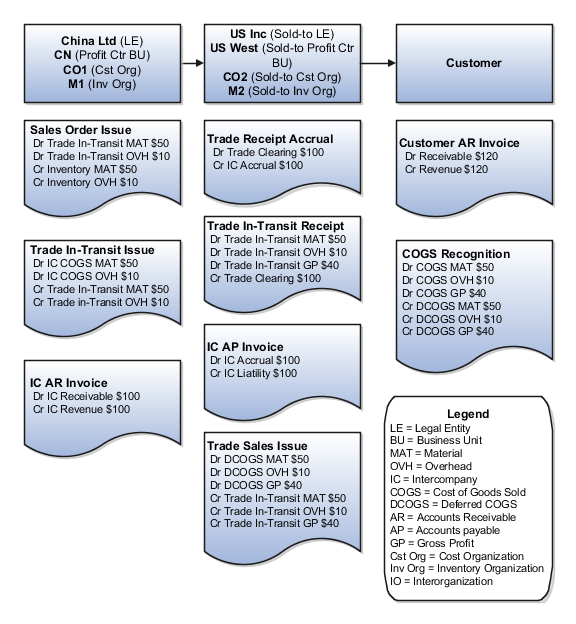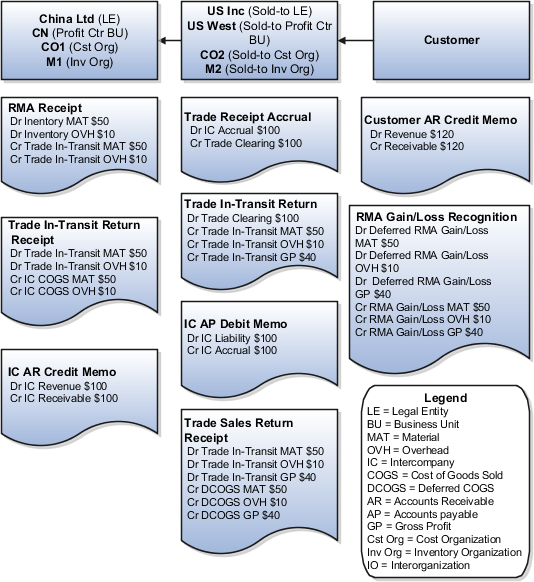Example of Accounting of Trade Transactions in Internal Drop Shipments
An internal drop shipment is a trade transaction involving the movement of goods from an inventory organization directly to a customer, yet the business unit that sells the goods to the customer is different from the business unit to which the inventory organization belongs.
From the financial standpoint, the business unit to which the inventory organization belongs sells the goods to the other business unit who, in turn, sells the goods to the customer.
The following is an example of accounting performed by Oracle Cost Accounting and Oracle Receipt Accounting for an internal drop shipment. It illustrates:
-
Transactions that are captured in Oracle Supply Chain Financial Orchestration and interfaced to Receipt Accounting and Cost Accounting.
-
Accounting entries that Receipt Accounting and Cost Accounting generate for the drop shipment flow from the selling organization to the customer of the buying organization.
-
Accounting entries that Receipt Accounting and Cost Accounting generate for the return flow from the customer to the seller.
Scenario
China Ltd. drop ships the goods to the customer of US Inc.
Transactions from Supply Chain Financial Orchestration
The trade agreement, accounting rule sets, and associated purchase orders are set up in Supply Chain Financial Orchestration, and the transactions flow into Receipt Accounting and Cost Accounting based on this setup:
-
China Ltd. acquires goods locally at the cost of USD 50, plus USD 10 overhead on the receipt of goods.
-
Intercompany transfer price from China Ltd. to US Inc. is USD 100.
-
Intercompany invoicing is set to Yes.
-
Overhead rule is configured in Cost Accounting for transaction type Trade in-Transit Receipt in Cost Organization CO1.
-
US Inc. books a profit of USD 40 (USD 100 transfer price - USD 50 PO price - USD 10 overhead).
Analysis
Receipt Accounting and Cost Accounting create accounting distributions for the transfer of goods.
Accounting Entries
The following figure illustrates accounting entries for the shipment from legal entity China Ltd. to legal entity US Inc.

Cost Accounting generates distributions under cost organization CO1 and inventory organization M1.
The following table describes the cost accounting entries.
|
Subledger |
Event Type |
Accounting Line Type |
Amount in Functional Currency +Dr/-Cr |
Functional Currency |
Cost Element |
Basis of Amount |
|---|---|---|---|---|---|---|
|
Cost Accounting |
Sales Order Issue |
Trade In-Transit |
50 |
USD |
Material |
Current Cost |
|
Cost Accounting |
Sales Order Issue |
Trade In-Transit |
10 |
USD |
Overhead |
Current Cost |
|
Cost Accounting |
Sales Order Issue |
Inventory |
-50 |
USD |
Material |
Current Cost |
|
Cost Accounting |
Sales Order Issue |
Inventory |
-10 |
USD |
Overhead |
Current Cost |
|
Cost Accounting |
Trade In-Transit Issue |
Intercompany Cost of Goods Sold |
50 |
USD |
Material |
Current Cost |
|
Cost Accounting |
Trade In-Transit Issue |
Intercompany Cost of Goods Sold |
10 |
USD |
Overhead |
Current Cost |
|
Cost Accounting |
Trade In-Transit Issue |
Trade In-Transit |
-50 |
USD |
Material |
Current Cost |
|
Cost Accounting |
Trade In-Transit Issue |
Trade In-Transit |
-10 |
USD |
Overhead |
Current Cost |
|
Accounts Receivable |
Intercompany Accounts Receivable Invoice |
Intercompany Receivable |
100 |
USD |
Not Applicable |
Transfer Price |
|
Accounts Receivable |
Intercompany Accounts Receivable Invoice |
Intercompany Revenue |
-100 |
USD |
Not Applicable |
Transfer Price |
Receipt Accounting generates distributions under business unit US West and inventory organization M2. Cost Accounting generates distributions under cost organization CO2 and inventory organization M2.
The following table describes the receipt and cost accounting entries.
|
Subledger |
Event Type |
Accounting Line Type |
Amount in Functional Currency +Dr/-Cr |
Functional Currency |
Cost Element |
Basis of Amount |
|---|---|---|---|---|---|---|
|
Receipt Accounting |
Trade Receipt Accrual |
Trade Clearing |
100 |
USD |
Not Applicable |
Transfer Price |
|
Receipt Accounting |
Trade Receipt Accrual |
Intercompany Accrual |
-100 |
USD |
Not Applicable |
Transfer Price |
|
Cost Accounting |
Trade In-Transit Receipt |
Trade In-Transit |
50 |
USD |
Material |
Sending Organization Cost |
|
Cost Accounting |
Trade In-Transit Receipt |
Trade In-Transit |
10 |
USD |
Overhead |
Sending Organization Cost |
|
Cost Accounting |
Trade In-Transit Receipt |
Trade In-Transit |
40 |
USD |
Profit in Inventory |
Internal Markup |
|
Cost Accounting |
Trade In-Transit Receipt |
Trade Clearing |
-100 |
USD |
Material, Overhead, and Profit in Inventory |
Transfer Price |
|
Accounts Payable |
Intercompany Accounts Payable Invoice |
Intercompany Accrual |
100 |
USD |
Not Applicable |
Transfer Price |
|
Accounts Payable |
Intercompany Accounts Payable Invoice |
Intercompany Liability |
-100 |
USD |
Not Applicable |
Transfer Price |
|
Cost Accounting |
Trade Sales Issue |
Deferred Cost of Goods Sold |
50 |
USD |
Material |
Sending Organization Cost |
|
Cost Accounting |
Trade Sales Issue |
Deferred Cost of Goods Sold |
10 |
USD |
Overhead |
Sending Organization Cost |
|
Cost Accounting |
Trade Sales Issue |
Deferred Cost of Goods Sold |
40 |
USD |
Profit in Inventory |
Internal Markup |
|
Cost Accounting |
Trade Sales Issue |
Trade In-Transit |
-50 |
USD |
Material |
Sending Organization Cost |
|
Cost Accounting |
Trade Sales Issue |
Trade In-Transit |
-10 |
USD |
Overhead |
Sending Organization Cost |
|
Cost Accounting |
Trade Sales Issue |
Trade In-Transit |
-40 |
USD |
Profit in Inventory |
Internal Markup |
The customer returns goods directly to China Ltd.
The following figure illustrates accounting entries for the return flow from US Inc (Sold-to Legal Entity) to China Ltd (Legal Entity).

Receipt Accounting generates distributions under business unit US West and inventory organization M2. Cost Accounting generates distributions under cost organization CO2 and inventory organization M2.
The following table describes those receipt and cost accounting entries.
|
Subledger |
Event Type |
Accounting Line Type |
Amount in Functional Currency +Dr/-Cr |
Functional Currency |
Cost Element |
Basis of Amount |
|---|---|---|---|---|---|---|
|
Receipt Accounting |
Trade Return Accrual |
Intercompany Accrual |
100 |
USD |
Not Applicable |
Transfer Price |
|
Receipt Accounting |
Trade Return Accrual |
Trade Clearing |
-100 |
USD |
Not Applicable |
Transfer Price |
|
Cost Accounting |
Trade In-Transit Return |
Trade Clearing |
100 |
USD |
Split into three lines (Material, Overhead, and Profit in Inventory) |
Transfer Price |
|
Cost Accounting |
Trade In-Transit Return |
Trade In-Transit |
-50 |
USD |
Material |
Sending Organization Cost |
|
Cost Accounting |
Trade In-Transit Return |
Trade In-Transit |
-10 |
USD |
Overhead |
Sending Organization Cost |
|
Cost Accounting |
Trade In-Transit Return |
Trade In-Transit |
-40 |
USD |
Profit in Inventory |
Internal Markup |
|
Accounts Payable |
Intercompany Accounts Payable Debit Memo |
Intercompany Liability |
100 |
USD |
Not Applicable |
Transfer Price |
|
Accounts Payable |
Intercompany Accounts Payable Debit Memo |
Intercompany Accrual |
-100 |
USD |
Not Applicable |
Transfer Price |
|
Cost Accounting |
Trade Sales Return Receipt |
Trade In-Transit |
50 |
USD |
Material |
Sending Organization Cost |
|
Cost Accounting |
Trade Sales Return Receipt |
Trade In-Transit |
10 |
USD |
Overhead |
Sending Organization Cost |
|
Cost Accounting |
Trade Sales Return Receipt |
Trade In-Transit |
40 |
USD |
Profit in Inventory |
Internal Markup |
|
Cost Accounting |
Trade Sales Return Receipt |
Deferred RMA Gain/Loss |
-50 |
USD |
Material |
Sending Organization Cost |
|
Cost Accounting |
Trade Sales Return Receipt |
Deferred RMA Gain/Loss |
-10 |
USD |
Overhead |
Sending Organization Cost |
|
Cost Accounting |
Trade Sales Return Receipt |
Deferred RMA Gain/Loss |
-40 |
USD |
Profit in Inventory |
Internal Markup |
Receipt Accounting generates distributions under business unit CN and inventory organization M1. Cost Accounting generates distributions under cost organization CO1 and inventory organization M1.
The following table describes those accounting entries.
|
Subledger |
Event Type |
Accounting Line Type |
Amount in Functional Currency +Dr/-Cr |
Functional Currency |
Cost Element |
Basis of Amount |
|---|---|---|---|---|---|---|
|
Cost Accounting |
RMA Receipt |
Inventory* |
50 |
USD |
Material |
Current Cost |
|
Cost Accounting |
RMA Receipt |
Inventory |
10 |
USD |
Overhead |
Current Cost |
|
Cost Accounting |
RMA Receipt |
Trade In-Transit |
-50 |
USD |
Material |
Current Cost |
|
Cost Accounting |
RMA Receipt |
Trade In-Transit |
-10 |
USD |
Overhead |
Current Cost |
|
Cost Accounting |
Trade In-Transit Return Receipt |
Trade In-Transit |
50 |
USD |
Material |
Current Cost |
|
Cost Accounting |
Trade In-Transit Return Receipt |
Trade In-Transit |
10 |
USD |
Overhead |
Current Cost |
|
Cost Accounting |
Trade In-Transit Return Receipt |
Intercompany Cost of Goods Sold |
-50 |
USD |
Material |
Current Cost |
|
Cost Accounting |
Trade In-Transit Return Receipt |
Intercompany Cost of Goods Sold |
-10 |
USD |
Overhead |
Current Cost |
|
Accounts Receivable |
Intercompany Accounts Receivable Credit Memo |
Intercompany Revenue |
100 |
USD |
Not Applicable |
Transfer Price |
|
Accounts Receivable |
Intercompany Accounts Receivable Credit Memo |
Intercompany Receivable |
-100 |
USD |
Not Applicable |
Transfer Price |
* Inventory is received at the current cost, and the difference between transfer price and cost is booked as cost variance.